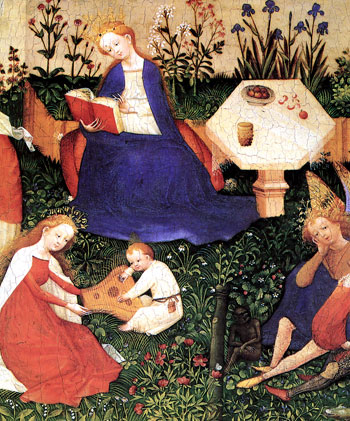 |
| Mary in a hortus conclusus |
One of my favourite periods of garden history and one which is sadly neglected is the Mediaeval garden. If you wish to know more, John Harvey's Mediaeval Gardens (1981) is a masterful tome. Albeit an expensive one these days. There are also a couple of blogs worth visiting: St Mary de Haura and The Medieval Garden Enclosed.
Monastic Self sufficiency
While the Islamic world grew in size and created
beautiful gardens, Europe entered a period well deserved of its title,
‘The Dark Ages’. The peaceful conditions required for ornamental garden
making were lost, but the missionary zeal of the monks took
Christianity swiftly across Europe, and since their Rule demanded
self-sufficiency, with it went the art of gardening.
 |
| Plan of St Gall - garden is in top left corner |
One 9th century document, a plan by Abbot Hiato of St Gall, a monastery in Switzerland shows a blueprint for the perfect monastery and reveals the garden to be full of raised, rectangular beds in each of which was grown a single crop. Monsativc gardens were made for utility and purpose - to provide plants to eat, from which to make medicines and to use in the everyday running of a monsatic establishment. They were not for ornament and repose, and by the late 11th century, the monasteries were large, well established, and powerful
Exotic Secular
 |
| Virgin and Child with Saints, c.1510-1520. Attribution: Fir0002/Flagstaffotos. GFDL Licence |
As a sort of peace settled across Europe, with its return, so did garden making – but protected
behind thick castle walls. Such enclosed gardens were often called hortus conclusus and had a religious overtone referring to Mary. However unlike monks, the nobility were neither celibate nor
ascetic and many had seen the erotic, sensuous Moorish (Islamic) gardens in
Spain, Sicily and on the Crusades. Thus Islamic influences began to creep into the garden.
 |
| The Abbey House Garden, Malmesbury |
The mediaeval garden mingled beauty with utility. It was a place for relaxation, and in a malodorous world, a retreat full of sweetly scented plants. Like the monasteries the plants were grown in raised beds, and many species still served medicinal or culinary uses, but they were grown in a way to make them look beautiful – a mix of species to create a floral tapestry. Other beds were raised further to make seats, and carpeted with fine turf richly sprinkled with herbs such as thyme, camomile and other fragrant plants. Alternatively the enclosed space was entirely covered in a ‘flowery mead’ - fine grass studded with many wild flowers.
Other popular features included arbours, the simplest being a structure of wooden poles cloaked with climbers such as honeysuckle, vine or clematis. More ornate frameworks were made from woven willow or wooden trellis. This notion of a romantic retreat received a fillip with the story of fair Rosamund Clifford, mistress to the English king, Henry II. In the grounds of Woodstock (now Blenheim Palace), the King built Rosamund a bower, where they had their trysts, until his jealous wife, Queen Eleanor of Aquitaine learned of their trysts and killed her rival.
 |
| An Enclosed Garden |
Ornate water features, especially tanks, baths, pools, and fountains were another favourite, as were mazes and labyrinths, often copied from patterns on Cathedral floors. However these were not mazes as we know them – tall yew hedges - instead they were patterns cut into turf.
The Normans loved hunting, and they must have heard tales of the great Assyrian pairadaeza full of exotic animals, trees and flowers. A ‘replica’ was built in 1123 by Henry I, who enclosed the park at Woodstock and stocked it with animals including lions, leopards, lynx, porcupine and camels.
The Normans loved hunting, and they must have heard tales of the great Assyrian pairadaeza full of exotic animals, trees and flowers. A ‘replica’ was built in 1123 by Henry I, who enclosed the park at Woodstock and stocked it with animals including lions, leopards, lynx, porcupine and camels.
P.S. The links of the above two images lead so some rather interesting, albeit not garden, facts. Try them if you dare.


No comments:
Post a Comment